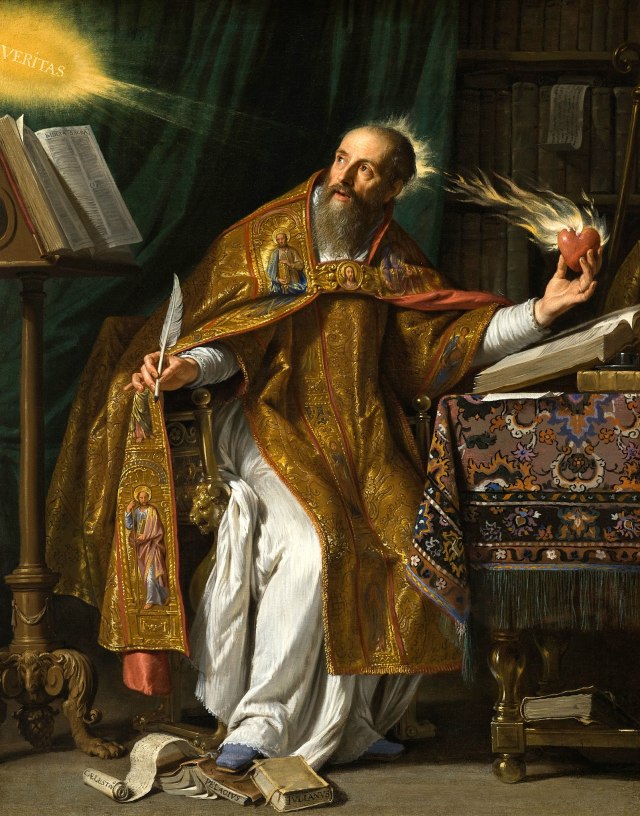PHILIPPE DE CHAMPAIGNE (1602-1674)
Saint Augustine (c.1645-50)
Oil on canvas (79 x 62 cm)
Los Angeles County Museum of Art
To enlarge the image, right-click on it, then “Open in a new tab”
The text reproduced below is the entry written by the great British art historian Philip Conisbee (1946-2008) for the catalogue of the exhibition “The Ahmanson Gifts” organised by the Los Angeles County Museum of Art (LACMA) in 1991. The notes are mine.
“Saint Augustine (AD 345-430) is revered as one of the four Latin Fathers of the Church, along with SS Ambrose, Gregory the Great, and Jerome. These theologians, writing in the early centuries of the rise of Christianity, debated and established many of the fundamental principles of the Catholic faith. During the Counter-Reformation of the 16th and 17th centuries, Catholic theologians looked back with sharpened interest at such early teachers and formulators of Christian doctrine. This reconsideration and reassertion of the intellectual foundations of Catholicism brought not only a renewed study of the original authors of dogma but a concomitant revival of pictorial imagery celebrating them and their achievements.
Philippe de Champaigne’s image of Saint Augustine is a typical work of the Counter-Reformation in France. It shows the revered saint seated in his book-lined study, which is more 17th century than 5th century in appearance. St. Augustine was Bishop of Hippo in North Africa so he is depicted wearing episcopal garments, with his mitre on the table and his pastoral staff leaning nearby. Edward Maeder, the curator of costumes and textiles at the museum, has pointed out that Champaigne clothed St. Augustine in Spanish ecclesiastical robes of the late 16th century. Such garments would have been readily available during and after the Spanish rule of the Low Countries, Champaigne’s native land. They are richly embroidered with gold thread and decorated with images of the Evangelists and other saints. The Turkish carpet over the table was probably one of his own studio props because he used the same rug in his great portrait of the lawyer Omer Talon (1649, National Gallery of Art, Washington DC)
St. Augustine pauses, quill pen in his hand, to look over his shoulder for inspiration. He gazes at a blaze of a divine light bearer of Veritas (Truth) which shines over a copy of the divinely inspired Biblia Sacra, the written source of Truth. In his hand, the saint holds a flaming heart, one of his traditional attributes, which denotes his religious ardour. On the floor, we can see a scroll and two books trampled under the saint’s foot. The names in these texts refer to Celestius, Pelagius and Julian of Eclanum. These three theologians were contemporaries of St. Augustine and engaged in acrimonious disputes with him over matters of doctrine According to St. Augustine, Pelagius and his two supporters were promoters of heretical ideas that undermined the true faith by questioning the doctrines of original sin, divine grace, and the baptism of children. (1)
The painting was lauded for its artistic merits and religious message, and as such, it was engraved and published in Paris by Nicolas de Poilly around the middle of the century. A Latin legend under the print reads Unde ardet, inde lucet (The flame of love becomes light). Poilly’s engraving was later copied by other 17th-century engravers. According to this data, we can date the painting to the mid-1640s.
After training in his native Brussels with landscape painter Jacques Fouquieres, Champaigne moved to Paris in 1621, becoming a French citizen in 1629. Worked on decorations at the Palais du Luxembourg and, in 1627 became peintre de la reine mère (painter to the Queen Mother). He found favour with Louis XIII and Cardinal Richelieu, whose portrait he painted several times. He was a founding member of the Royal Academy of Painting and Sculpture in 1648, official painter to the magistrates of Paris, and a well-known portraitist. As a fervent Catholic, he also worked for religious orders, including the Carmelites and the Carthusians. These official and semi-official positions enabled Champaigne to remain connected without trouble to the French Jansenists, who were confined to the abbey of Port-Royal. This order, whose austere doctrines were influenced by St. Augustine, was based on the writings of the Dutch theologist Cornelius Jansen or Jansenius hence its name. It was the centre of political and religious controversy and was opposed by the powerful Jesuits and, eventually, the Pope himself.
Saint Augustine is thoroughly typical of Champaigne’s style. While there is a certain sharpness in the outline of the figure and the details this is the product of the rigorous French academic training that placed an emphasis on the excellence of the drawing, its strong, rich colour and fine technique place it in the traditions of Flemish painting. The saint is vividly characterized and every detail is sharply delineated: lectern, books, table, carpet and, above all, the splendid bishop’s vestments, whose richly coloured embroidery contrasts with the creamy white of the surplice. The whole image radiates with an intensity that reflects and expresses the passionate spirituality of the saint.”
(1) The “acrimonious disputes” were the result of Augustine’s own fanaticism and intolerance. These have always been the hallmarks of Christianity, an off-shoot of Judaism of which it inherited its arrogant belief of being the only “true” religion; something that would later be adopted by another fanatic called Mohamed. It is to these three intolerant, hateful religions that we have to thank for centuries of blood shed and wars.

